Material Culture: Week 9: Sculptures
1/71
There's no tags or description
Looks like no tags are added yet.
Name | Mastery | Learn | Test | Matching | Spaced |
|---|
No study sessions yet.
72 Terms
What are the different medias that sculpture can be made in?
Different media: stone, marble, bronze, wood, terracotta, precious metals, ivory
What different forms can sculpture be found in?
Different forms: free-standing, pedimental, relief
What different contexts can sculpture be found in?
Different contexts: funerary, religious, public, domestic
What content can be found in sculpture?
Different contents: gods, humans,athletes, mythical figures, everyday
What do later periods of sculpture have?
Later periods have a wider range of sculpture from a wider range of places due to archeological excavation and plac es that people have investigated (and they were just using statues more widely)
How do we study scultoure?
Artists- who made it
Visual appearance- form style technique
Content and iconography- what does it show and how o we know this
Context and function- why was it made, where was it displayed, what purpose did it serve (a victory statue? Dedicated to the gods?
When is the gerometric period?
900-700 BC
When is the Archaic period?
700-480 BC
When is the classical period?
480-323 (divides into high classical: 5th C, and late Classical 4th Century)
When is the Hellenistic period?
323-31 BC)
When is the roman period?
31 BC-4/5th C
Give an example of a bonze geometric figurine:
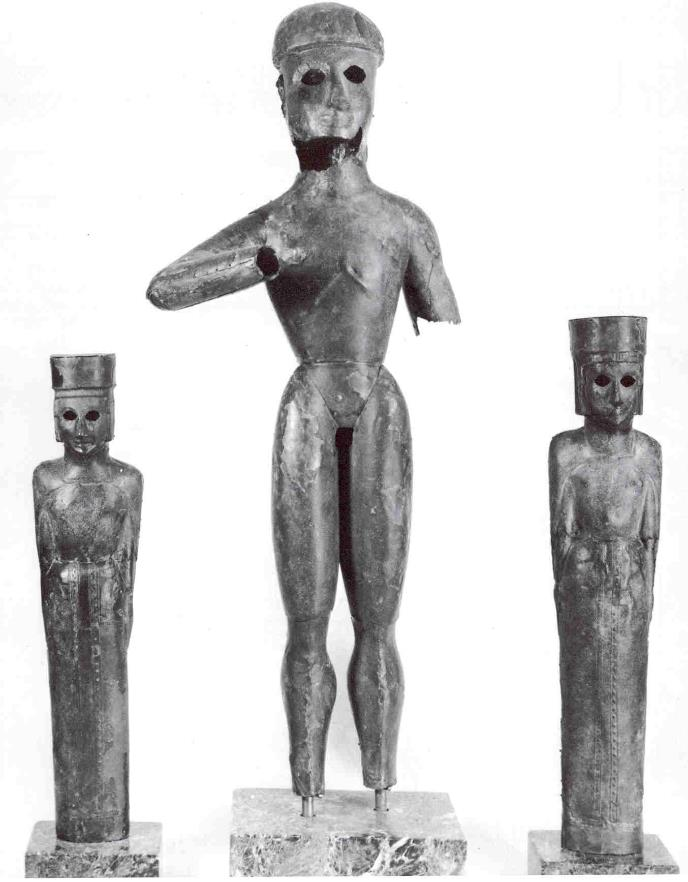
What do we now about this figurine?
Daedalic Style, 7th C BC
Apollo, Leto and Artemis Temple of Apollo, Dreros, Crete c. 700BC
Hammered bronze (sphyrelaton)
80 and 40 cm high. Heraklion.
What began to chaneg after the hellenistic period?
This later on changed into more naturalistic images
What in sculpture was explored in the Hellenistic period?
In the Hellenistic period they tried to explore more realistic bodies, emphasising ages and wrinkles (in the roman period)
How was the human body depicted in the archaic period?
Archaic: static, schematic depictions of the body, characterised by frontal appearance and archaic smile, large eyes,
How were human bodies depicted in the classical period?
Classical: naturalistic, sense of a narrative
How was the human body depicted in the hellenistic period?
Hellenistic: exaggerated forms, encourage a variety of view points.
How was the human body depicted in the late antique?
Late Antique: return to schematic forms, exaggerated eyes
What material can statues be made of?
•Wood
•Stone/Marble
•Bronze (solid cast or via lost wax technique)
•Precious metals
•Ivory
•Terracotta
Give an example of a wooden statue:
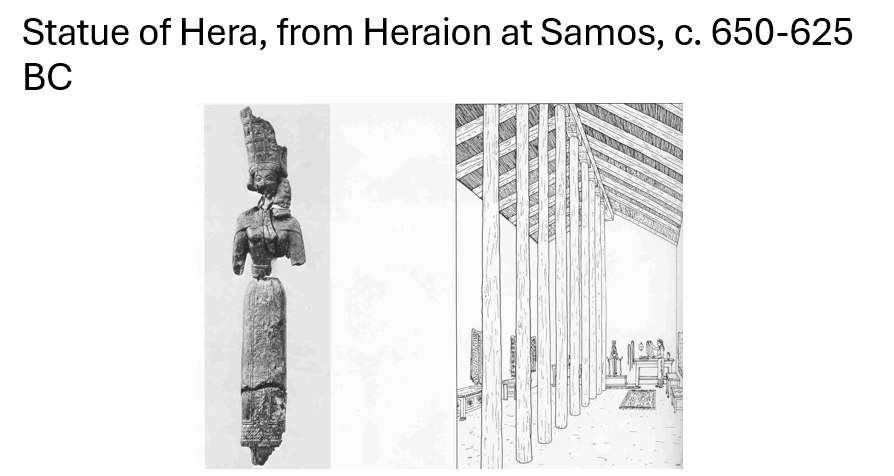
Give an example of an ivory statue:
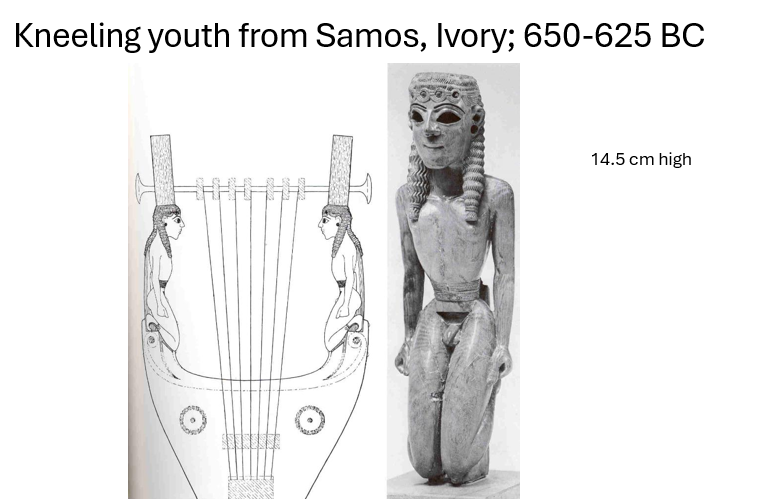
Give an example of a bronze statue:

How was cast bronze used for statues?
Cast bronze: used for solid bronze, custom tomb pieces or hollow bronze uses called cast bronze used for small statuettes
What is a kouros/kouroi?
Kouros is the modern term given to free-standing Ancient Greek sculptures that depict nude male youths
What are the characteristic features of a kouroi?
Characteristic features: weight equally balanced on two legs with one a bit further forward, large archaic eyes, ‘the archaic style’ meaning a fake smile. Features of the anatomy are compared to geometric forms
What are differences between greek and egyptian kouros’?
greek ones are shown naked but egyptian ones are shown with clothes covering them
How did the kouros scultpures develop?
These sculptures developed over time from a schematic representation of a human body to an accurate portrayal of a human body
How are these sculptures dated?
A lot of these sculptures are only dated stylistically, so there arent a lot of hard dates to hold on to
Where is this statue from?
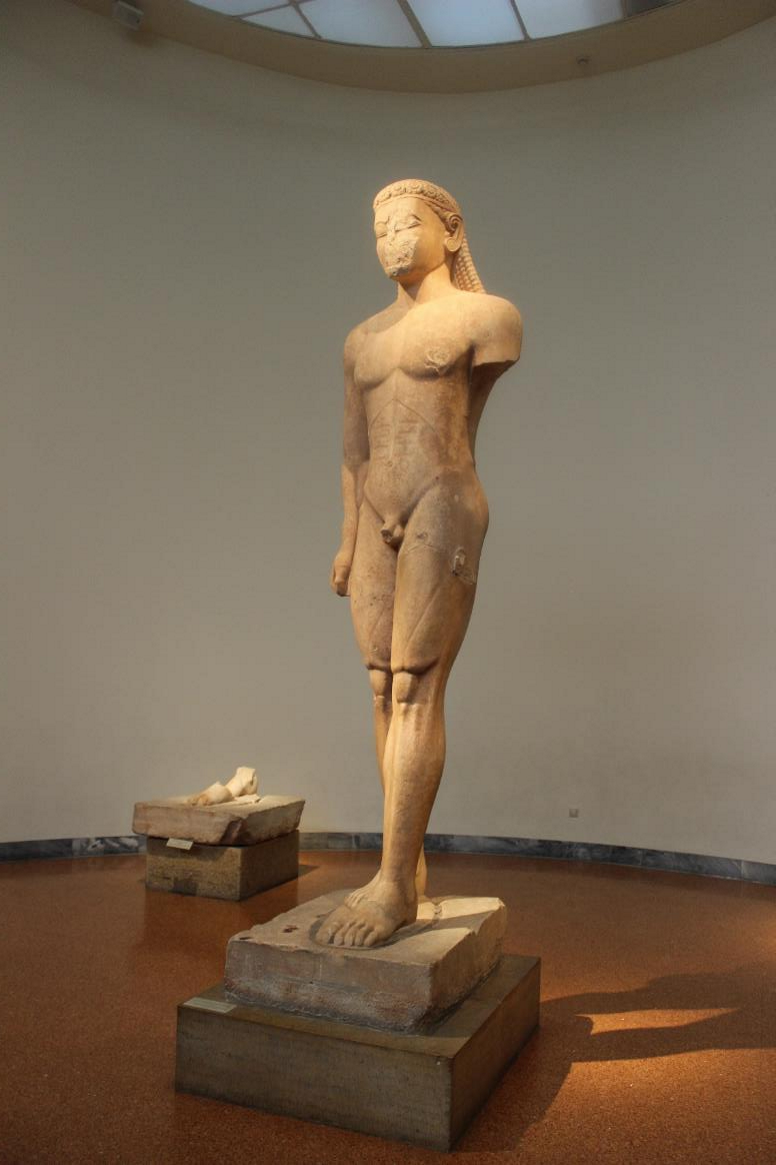
Contexts: Colossal Apollo of the Naxians, c. 600-575 BC
Kourai at Temple of Poseidon Sounion, c.600-575 BC
What did everyone believe these kouroi were at first?
Originally when these were discovered they were all thought to be apollo (because they are youthful, have long hair)
What are the scale of kourai?
Scale: some are colossal, others are lifesize
What contexts did the kourai have to funerary statues?
Funerary- some have been dedicated in funerary contexts and were found with inscriptions, inscribed with the persons name on them
Are the kourai individuals or general representations?
In most cases its unclear if they are individuals or a general representation
When and where is this statue from?

Kroisos, c. 530BC, from Anavyssos, Attica
What does the inscription at the base of the statue say?
Inscription on base (probably belongs to statue):
‘Stay and mourn at the monument (ΣΕΜΑ) for dead Kroisos whom violent Ares destroyed, fighting in the front rank’
What does the inscription state?
Inscriptions states he would have fought in the front rank, not the youngest or oldest person probably 30-40, the statue doesn't seem to represent anyone its very generic
What would we expect of this statue if he had faught in war?
We might expect him to be depicted in armour if he had fought in war, the sepcificity of the insciption verusus the generalness of the statue.
Who does the statue stand for?
The statue stands for Kroisos if it was on the base, but it doesn't show him in his moment of death- an idealised image alongside a specific inscription
What does korai mean?
It is a statue of a maiden
List examples of korai votives:
•Nicandre’s kore
•Cheramyes’ kore from Samos
•Korai from Athenian Acropolis
What statue is this and give info on it:
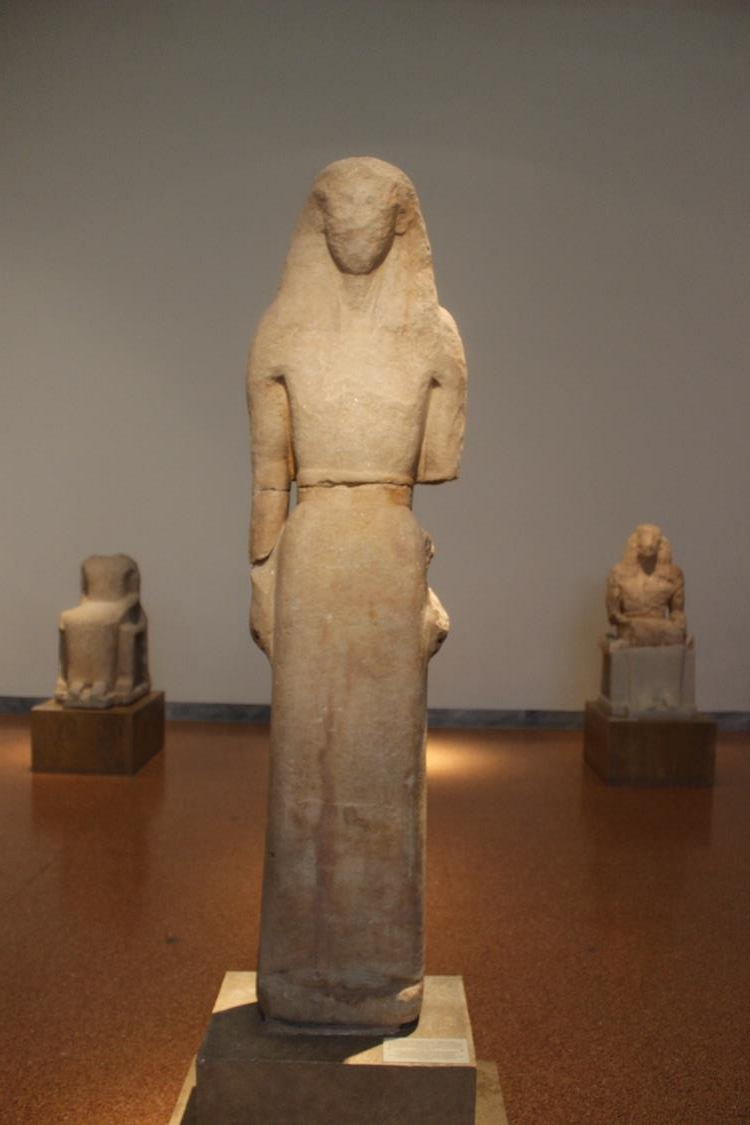
Kore dedicated by Nicandre to Artemis, from Delos c. 650-625 (Athens Nat Mus) 1.75 m high
What does the inscription on the left side of the statue say?
‘Nikandre dedicated me to the far-shooter of arrows, the excellent daughter of Deinodikes of Naxos, sister of Deinomenes, wife of Phraxos’- defining herself by her relationships with men. Many scholars believe that this represents Artemis herself as there is a hole of one had that could have been holdling a bow
Idenitfy this statue:

Kore from Samos, dedicated by Cheramyes, c. 560 BC
‘Cheramyes set me up as an agalma (offering) to Hera’
Feet are together and most have one hand at the side and the other is crossed over the chest or gesturing. This one was set up as an offering to hera
Analyse these statues:
Peplos Korai on the left and the right one is highlydecorated
They are often show ith a lot of jewlery, images of wealth and luxury- representing the wealth of the doner, a gift of a beautiful woman who will bring joy to whoever its dedicated to
Identify this statue:

Phrasikleia, from cemetary at Merenda, Attica. C. 550 BC
Inscription:
‘Marker of Phrasikleia. I shall ever be known as maiden (kore), the gods allotted me this title in place of marriage, Aristion of Paros made me’
Idenity this statue:
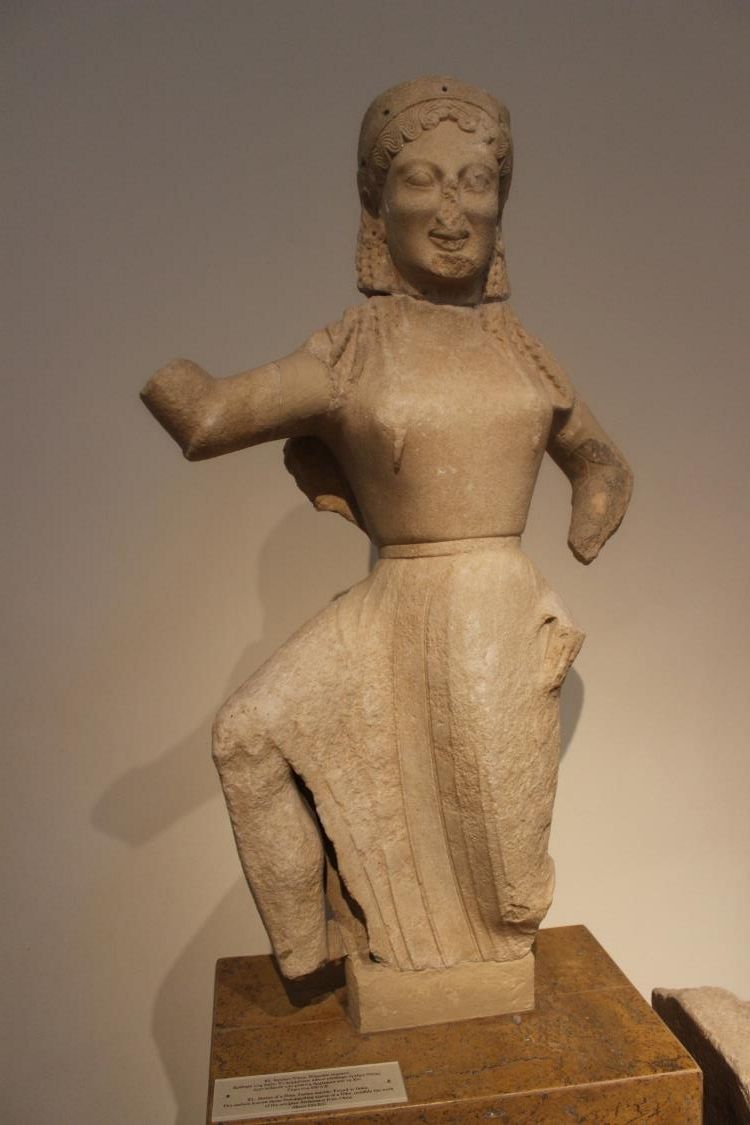
Nike of Archermos, from Delos, c. 550 BC
Inscription on base (prob belongs): ‘Farshooter Apollo receive this fine figure [made by] the skills of Archermos, from the Chian Mikkiades’
What did the archaic kourai change to?
Classical naturalism
What are problems with the body in classical art?
Lost bronze originals and Roman cpies: Kopienkritik
Much of the history written from surviving literary sources and the roman copies
But we do have some originals: architectural sculpture, Riace bronzes etc
Give an example of a more naturalistic statue/statues:
East pediment of temple of Zeus at Olympia c.460 BC is far more naturalistic
What is there often a sense of in classical sculpture?
Often a sense of narrative in classical sculpture, they often arent looking at you their head is turned away which creates a sense of them being part of a story that we arent involved in
What did Lucian (a historic figure) say about statues?
•'Have you not observed on coming in', he said, 'a very fine statue set up in the hall, the work of Demetrius, the maker of portrait statues?' 'Do you mean the discus-thrower' said I, 'the one bent over in the position of the throw, with his head turned back towards the hand that holds the discus, with one leg slightly bent, looking as. if he would spring up all at once with the cast?' 'Not that one' said he, 'for that is one of Myron's works, you are talking about the discobolos. Neither do I mean the one beside it, the one binding his head with the fillet (diadoumenos), the handsome lad, for that is Polykleitos' work. Never mind about those to the right as you come in, among which stand the tyrant-slayers, modelled by Kritios and Nesiotes...'
Put in an image of the statue Lucian was taking about:
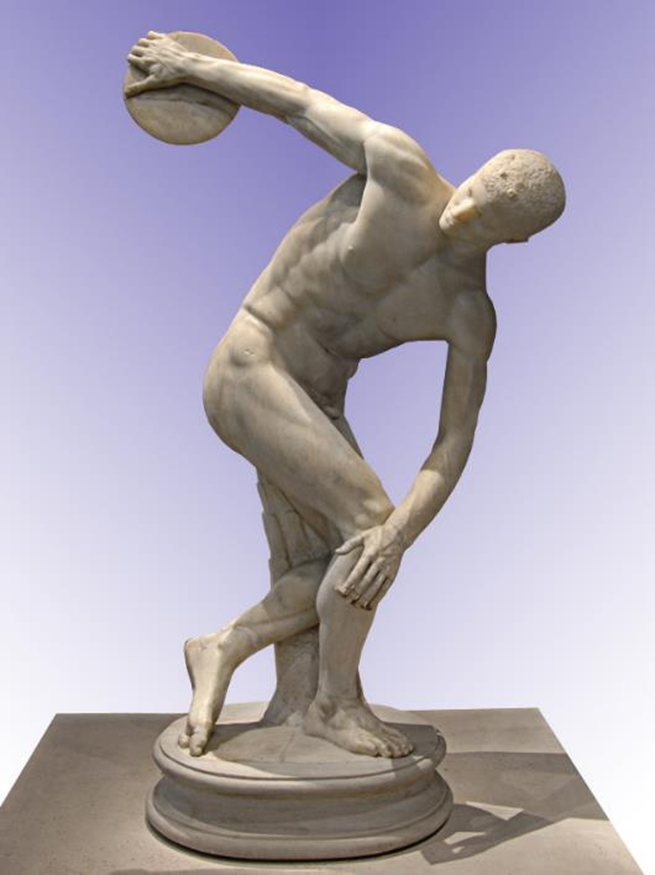
What is this statue:
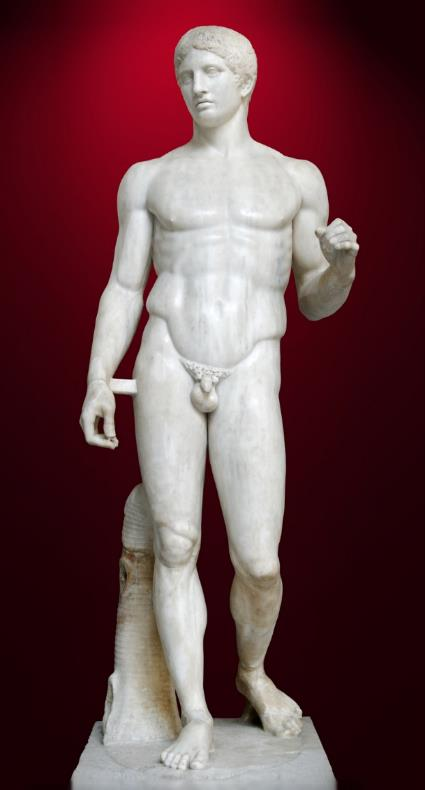
Polykleitos’ Doryphoros c. 440 BC
What did Pliny say about this statue?
Polyclitus of Sicyon, a pupil of Hegeladas, made a ‘Diadoumenus’, a supple youth, famous for having cost 100 talents, and a ‘Doryphorus’, a virile looking boy. He also made a statue that artists call the ‘Canon’ and from which they derive the principles of their art, as if from a law of some kind, and he alone of men is deemed to have rendered art itself in a work of art…it was strictly his invention to have his statues throw their weight onto one leg.
Analyse the statue:
Characteristic of having one leg bear all the weight (Contrapposto statue, contrapposto refers to a stance the statue is in). The original was in bronze Best known Roman copy one in Naples Arch museum.Associated with Polykleitos’ ‘kanon’ Proportions 1:7
Identify this statue:
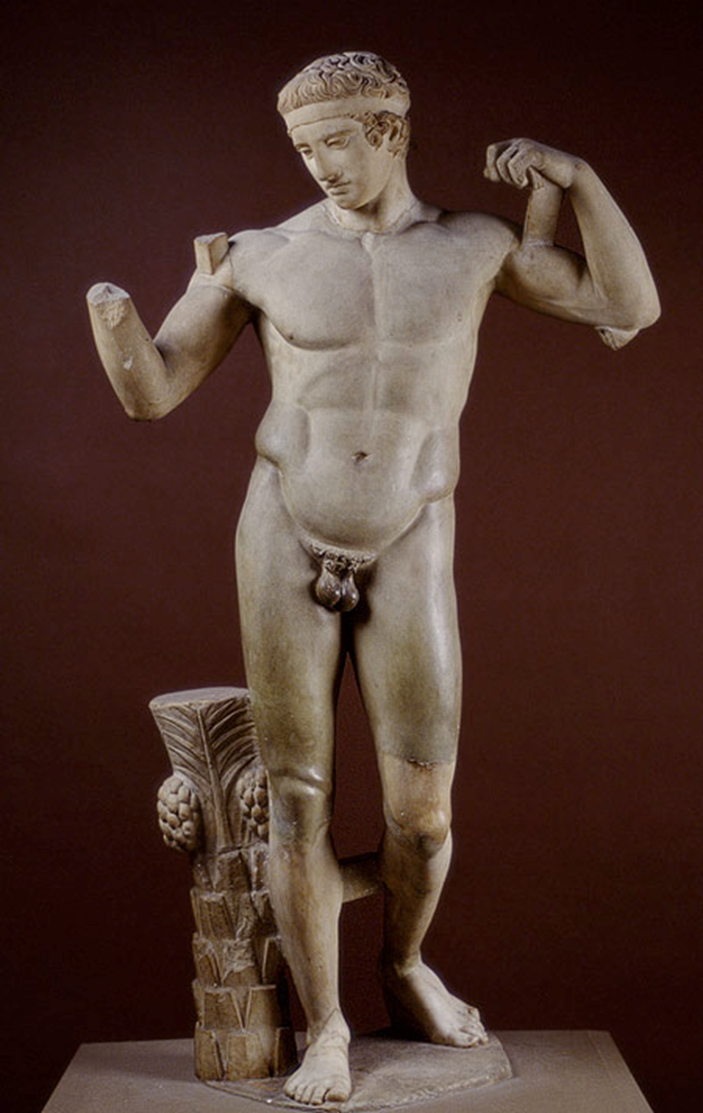
Polykleitos’ Diadoumenos, c. 530 BC
Analyse this statue (what its made of and who it is):
In marble this statue would have to have supports to be able to hold it up, while in bronze this wouldnt be necessary. We are unsure if the original statue was an athlete, a god or a mythological hero
Who were two famous sculptors in 4th C BC?
Praxiteles c. 375-350? (associated with Hermes and Dionysus state in the Olympia Museum)
Lysippus c. 360s to 316 BC
What statue was Praxiteles wasked to make?
Praxiteles was asked to make a statue of Aphrodite, he made two a nude one and a clothed one, the clothed one was bought by the people who commissioned it. We dont have the originals of these statues. The nude statue has her holding clothes about to put them down as if she was about to get in the bath
Show the pictures of the statues Praxiteles made:
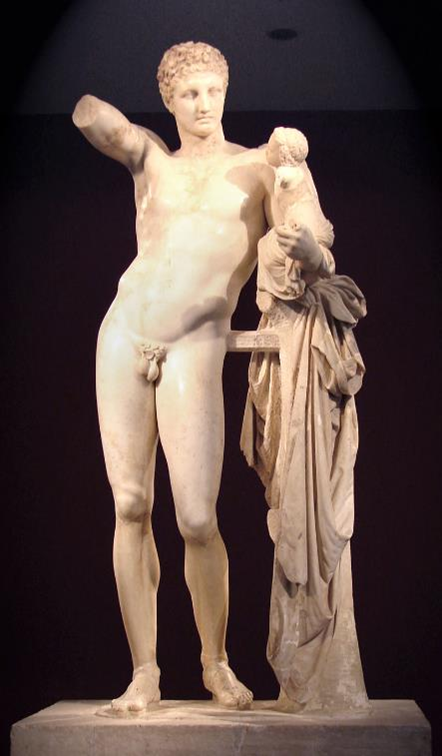
What do we know about Lysippus?
He was the one who made his bodies leaner/more slender
He was the court artist of Alexander the great, he chosen Lysippius as he believed he best represented Alexanders appearance
How did statues change in the Hellenistic period?
More exaggerated bodies, (from naturalism to realism and hyperrealism)
What did Hellenistic/Hellenistic baroque statues show?
Hellenistic showed statues where the bodiers werent all idealised and beautiful, they showed the reality of life
Hellenistic baroque- images of pain, emotion e.g. the statue of Laocoon (with his two sons and the snakes)
What is the name of this statue:
Farnese Hercules
When are where is the statue from?
A statue created in Roman period, early 3rd C AD
Found in the Baths of Caracalla, Rome
Who created the statue?
Signed by the sculptor Glykon of Athens,
But thought to be copy/reworking of a sculpture by 4th C BC sculptor Lysippus
What does it show? Discuss the style and iconography
Holding the lion skin and his club, the attributes of hercules
In his hand at the back he is holding apples, connected to the apple of hesperides (shown in a relaxed state post labours)
Hypermuscular, broad chest and shoulders (debate if the original statue would have looked like), also fits as he is known as an athlete
Pose- casual manner, leaning almost resting. Tilted neck and twist of the hips, weight bearing leg late 4th C BC
What does the fact that its signed tell us?
Interesting that it is signed by the sculpture, suggests the sculpture is proud of his work (we may view it as a copy of Lyssipus, but this work was carved by someone, and he is cevidently proud of it)
What is the problem with roman art?
Aesthetic revolution
Historical development
Terminology, what does roman sculpture mean, sculpture created int he period or in the area
They are building on all the work that has come before, so they combines parts from all over greek sculpture history therefore making it hard to date
What sort of statues come from greece, rome and provincial areas?
Greek influence- copies and adaptions
Roman- veristic portraits, historical reliefs, plebian art
Provinicial styles: funerary bust, Palmyra Syria
What contexts do we have to understand about statues/where would they have been displayed?
Sanctuaries
Public spaces: Forum, Baths, Theatres
Domestic spaces: villas and houses
Greek originals and Roman copies
Roman portraiture